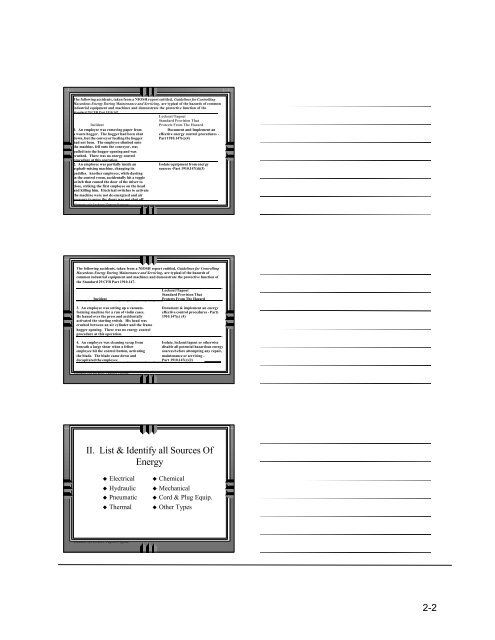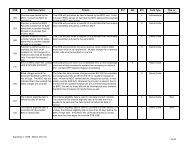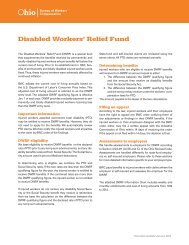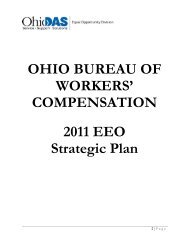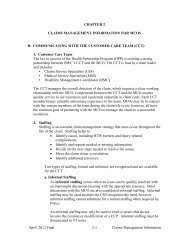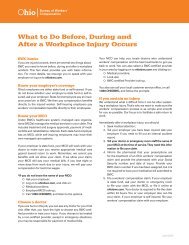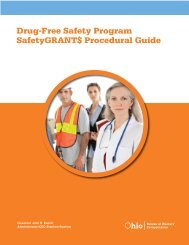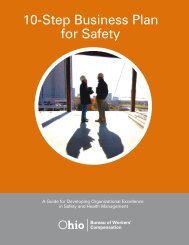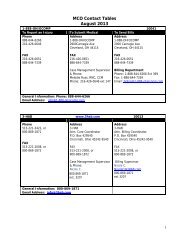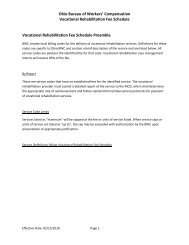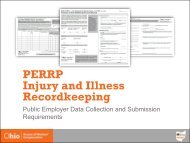Lockout / Tagout - Ohio Bureau of Workers' Compensation
Lockout / Tagout - Ohio Bureau of Workers' Compensation
Lockout / Tagout - Ohio Bureau of Workers' Compensation
Create successful ePaper yourself
Turn your PDF publications into a flip-book with our unique Google optimized e-Paper software.
The following accidents, taken from a NIOSH report entitled, Guidelines for Controlling<br />
Hazardous Energy During Maintenance and Servicing, are typical <strong>of</strong> the hazards <strong>of</strong> common<br />
industrial equipment and machines and demonstrate the protective function <strong>of</strong> the<br />
Standard 29 CFR Part 1910.147<br />
<strong>Lockout</strong>/<strong>Tagout</strong><br />
Standard Provision That<br />
Incident<br />
Protects From The Hazard<br />
1. An employee was removing paper from Document and Implement an<br />
a waste hogger. The hogger had been shut effective energy control procedures -<br />
down, but the conveyor feeding the hogger Part 1910.147(c)(4)<br />
had not been. The employee climbed onto<br />
the machine, fell onto the conveyor, was<br />
pulled into the hogger opening and was<br />
crushed. There was no energy control<br />
procedure at this operation.<br />
2. An employee was partially inside an Isolate equipment from energy<br />
asphalt-mixing machine, changing its<br />
sources -Part 1910.147(d)(3)<br />
paddles. Another employee, while dusting<br />
in the control room, accidentally hit a toggle<br />
switch that caused the door <strong>of</strong> the mixer to<br />
close, striking the first employee on the head<br />
and killing him. Electrical switches to activate<br />
the machine were not de-energized and air<br />
pressure to move the doors was not shut <strong>of</strong>f.<br />
Elements <strong>of</strong> a <strong>Lockout</strong> / <strong>Tagout</strong> Program<br />
The following accidents, taken from a NIOSH report entitled, Guidelines for Controlling<br />
Hazardous Energy During Maintenance and Servicing, are typical <strong>of</strong> the hazards <strong>of</strong><br />
common industrial equipment and machines and demonstrate the protective function <strong>of</strong><br />
the Standard 29 CFR Part 1910.147.<br />
Incident<br />
<strong>Lockout</strong>/<strong>Tagout</strong><br />
Standard Provision That<br />
Protects From The Hazard<br />
3. An employee was setting up a vacuum- Document & implement an energy<br />
forming machine for a run <strong>of</strong> violin cases. effective control procedures - Part)<br />
He leaned over the press and accidentally 1910.147(c) (4)<br />
activated the starting switch. His head was<br />
crushed between an air cylinder and the frame<br />
hogger opening. There was no energy control<br />
procedure at this operation.<br />
4. An employee was cleaning scrap from Isolate, lockout/tagout or otherwise<br />
beneath a large shear when a fellow<br />
disable all potential hazardous energy<br />
employee hit the control button, activating sources b efore attempting any repair,<br />
the blade. The blade came down and maintenance or servicing –<br />
decapitated the employee<br />
Part 1910.147(c)(2)<br />
Elements <strong>of</strong> a <strong>Lockout</strong> / <strong>Tagout</strong> Program<br />
II. List & Identify all Sources Of<br />
Energy<br />
u Electrical<br />
u Hydraulic<br />
u Pneumatic<br />
u Thermal<br />
u Chemical<br />
u Mechanical<br />
u Cord & Plug Equip.<br />
u Other Types<br />
Elements <strong>of</strong> a <strong>Lockout</strong> / <strong>Tagout</strong> Program<br />
2-2


